 Like Coffee, growing Cacao is very popular here in Puerto Rico. Basically, if one can grow coffee, then one can grow Cacao. It needs the shade of overgrowth and protection from strong wind that large trees can provide.
Like Coffee, growing Cacao is very popular here in Puerto Rico. Basically, if one can grow coffee, then one can grow Cacao. It needs the shade of overgrowth and protection from strong wind that large trees can provide. 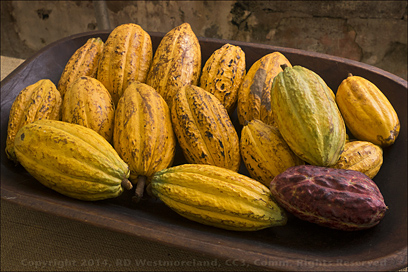
This makes Cacao perfect for planting among taller things.
So when a Cacao seminar in English was scheduled for Hacienda Buena Vista, we had to go!
Hacienda Buena Vista Revisited
I did a pretty detailed story about Hacienda Buena Vista awhile back. I also did a short YouTube video shot ‘from the road’ showing how to get there. Simply, once you get on Highway123, you cannot miss the place. It will be on the left. Parking is still an issue. Get there early to get in line or you might find yourself parking in the road.  I would normally penalize a place for this issue, but parking is almost always an issue, no matter where you go in PR.
I would normally penalize a place for this issue, but parking is almost always an issue, no matter where you go in PR.
Hacienda Buena Vista is up above Ponce and dates back to the days of slavery. When slavery ended a few decades later, it became uneconomical to maintain. They grew coffee for export and made corn meal for the local market which they ground themselves. The corn was imported and hauled from the port in Ponce in sacks of whole kernel corn. The restoration of the facility by the Puerto Rico Conservation Trust (Fideicomiso de Conservación) is quite remarkable as it is fully functional. They fire up the water wheel driven mill for every tour. It’s quite impressive. For those mechanically inclined, they have the only water driven turbine still in working order, in the world. 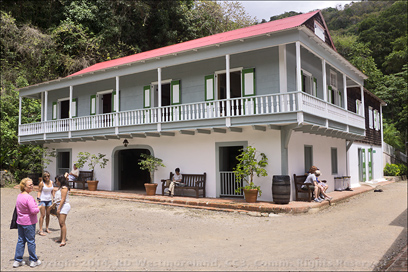 If this interests you, there are more details over on the Wikipedia page.
If this interests you, there are more details over on the Wikipedia page.
If you want shots of the ‘inner-workings’, a wide angle lens and high ISO is the rule of the day. I did not have to use a flash to get my shots.
The weather was typical for this time of year, especially since we are up in the mountains. Overcast, with small breaks of sunshine now and then. That’s when I grabbed most of my shots. I thought that it might start to rain, but it didn’t. The skies did get quite a bit darker as were getting ready to leave. 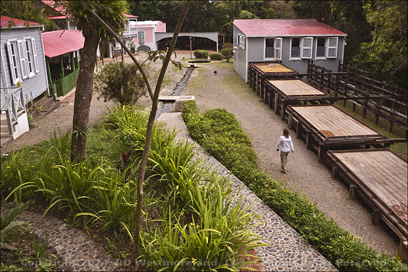 Warning: They have a “no refund” policy so if it does rain, you better whip out that umbrella you brought with you. You did remember to bring it, right?
Warning: They have a “no refund” policy so if it does rain, you better whip out that umbrella you brought with you. You did remember to bring it, right?
I did have certain expectations about the day’s one and a half hour presentation.
The event was billed by the Conservation Trust as a seminar on how Cacao is grown, through how the beans are processed into chocolate. What I did not realize was, it included the full tour of the facility as well. But that makes perfect sense.
It is worth noting that growing Cacao was not part of the original plantation, but it is a perfect fit for the facility. I for one, am glad they added it to the program. 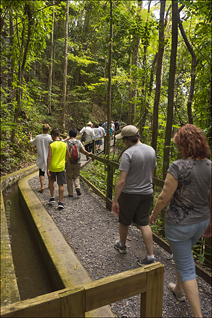 There is a lot of public interest in Cacao and chocolate, both locally and with tourists. Part of our own garden effort includes 5 red Cacao I have in pots now. They will be going into the ground this summer. More details about that, in a future post.
There is a lot of public interest in Cacao and chocolate, both locally and with tourists. Part of our own garden effort includes 5 red Cacao I have in pots now. They will be going into the ground this summer. More details about that, in a future post.
Our guide for the day was Alexandra.
Though English was obviously not her first language, she did quite well and I had no problem understanding her. Most of the folks that work here speak little, if any English. This facility is also quite popular with school kids so there are a lot more tours given in Spanish than English.
Once we gathered, Alexandra explained the things we would cover for the day with a little history on the place and then lead us up to the aqueducts, just above the main mill. The trek out to the end of the aqueduct where it meets the river is the longest stretch of the walk. 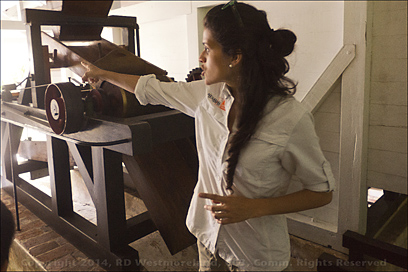 Since it follows the grade of the aqueduct, it is very easy to do. No climbing involved. We had done this before so we held back some to photograph the aqueduct and bridge in more detail. What we missed were the Cacao trees which had been planted out that way. My bad. All of the paths and walkways are very well maintained, though most of it is not wheelchair accessible. Not all things can be made accessible for everybody, sorry to say.
Since it follows the grade of the aqueduct, it is very easy to do. No climbing involved. We had done this before so we held back some to photograph the aqueduct and bridge in more detail. What we missed were the Cacao trees which had been planted out that way. My bad. All of the paths and walkways are very well maintained, though most of it is not wheelchair accessible. Not all things can be made accessible for everybody, sorry to say.
The Puerto Rico Conservation Trust does suggest wearing good shoes since there is some walking and steep steps to negotiate. That said, it might be 1/2 of a mile in total with a lot of pauses. 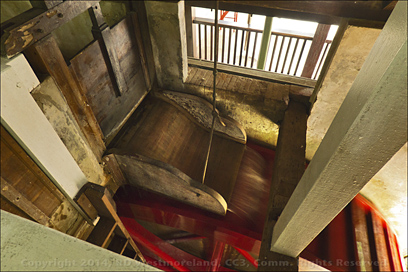 Even with my bad ankles it was doable.
Even with my bad ankles it was doable.
We came back to the main mill where she explained how coffee and cacao were processed differently and watched as an operator tossed the lever to turn the whole thing on.
The water path is diverted to the main water wheel forcing the machines to kick on.
It really is amazing to see.
After that, she took the group on down to the corn mill and where some of the coffee is planted. Then the group returned to the main house or Hacienda for that part of the tour. There are also corrals with a donkey and a mule, but they are just for show. 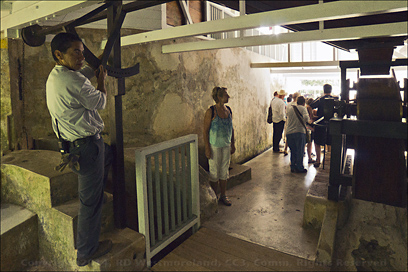 The slave quarters with large custom drying tables stored underneath, figure prominently into the ‘big picture’ of the period. These drying tables are on steel wheels and rails so as to enable sliding the drying harvest out of harms way in case of rain. These are also good for drying the cacao beans, after they have been washed and allowed to ferment for a few days.
The slave quarters with large custom drying tables stored underneath, figure prominently into the ‘big picture’ of the period. These drying tables are on steel wheels and rails so as to enable sliding the drying harvest out of harms way in case of rain. These are also good for drying the cacao beans, after they have been washed and allowed to ferment for a few days.
The last part of the tour was a tent covered display demonstrating how cacao was roasted by hand, shelled from its thin husk and then ground in a giant Pilon by hand to make the raw cocoa.
Pilones are a Puerto Rican tradition. A type of wooden mortar and pestle. Every kitchen in 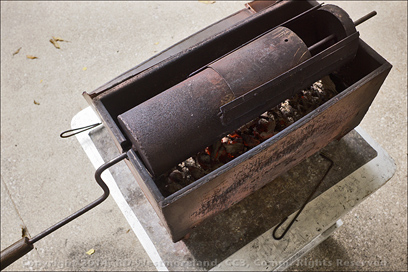 PR has one for crushing garlic and spices and making Mofongo. You can see artisans selling them from the side of the road, almost anywhere you go. The original ‘food processor’.
PR has one for crushing garlic and spices and making Mofongo. You can see artisans selling them from the side of the road, almost anywhere you go. The original ‘food processor’.
The smell of roasting cacao beans were every bit as aromatic as roasted coffee.
I got to try a freshly roasted cacao bean… it was very interesting. Not as gritty as eating a coffee bean (ever had the chocolate covered ones?), with mild fruity notes and an earthy quality I found very delicious. I could do more of these. 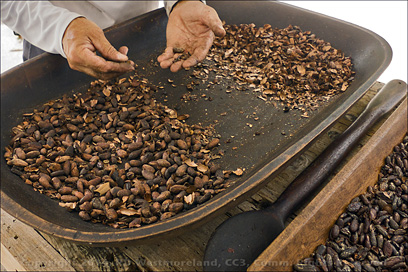 The large fruit the beans comes from are supposed to be edible too, but I have yet to try it. Cut open, they resemble a squash or papaya, but with a cluster of very large beans inside.
The large fruit the beans comes from are supposed to be edible too, but I have yet to try it. Cut open, they resemble a squash or papaya, but with a cluster of very large beans inside.
This is where our tour concluded for the day.
We have a much better idea now as to how to make raw cocoa from ‘fresh beans’. Something we are looking most forward to. Now I’ll need to figure out how to make a small rotating roaster like the one in the shot. It would also work for roasting coffee.  On our way out, we scored 7 of the yellow cacao seedlings to complement the ones we already have. At $3 bucks each, they were a bargain.
On our way out, we scored 7 of the yellow cacao seedlings to complement the ones we already have. At $3 bucks each, they were a bargain.
The tour costs $10 for adults, $7 for seniors and children.
Don’t forget, the fees are non-refundable and would require rescheduling in case of rain other than light showers so you might want to check the weather before making reservations. Advance reservations are required since they are not set up to take payments once you get there. 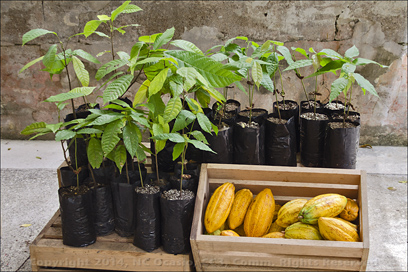 Reservations can be made on-line or over the phone in either Spanish or English, no problem. There was an issue with the website the day we tried to make our reservations… it kept sending us to a different tour when we tried to pay for it so we ended up making ours over the phone (787-722-5882). No biggie! If you have the time, the Conservation Trust, a non-profit organization has many other activities worth checking out, all at reasonable prices.
Reservations can be made on-line or over the phone in either Spanish or English, no problem. There was an issue with the website the day we tried to make our reservations… it kept sending us to a different tour when we tried to pay for it so we ended up making ours over the phone (787-722-5882). No biggie! If you have the time, the Conservation Trust, a non-profit organization has many other activities worth checking out, all at reasonable prices.
I consider the guided tour of Hacienda Buena Vista one of the TOP 12 THINGS TO SEE AND DO while visiting Puerto Rico. I’ve been twice and will be back again for sure. Even with the minor hassles, it is a MUST SEE!
A special thanks to our guide and host for the day, Alexandra.
Arrg!
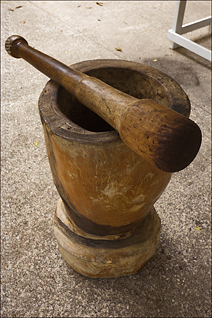
Damun Gracenin says
Roberto, Thank you for this. I would love this tour, and I would love to explore the cocoa world here. We are in Puerto Rico after Hurricane Maria, helping to pick up the pieces. Because we work 7 days a week, we have not had a chance to explore — but site visits in the mountains hint at the world of cacao & coffee. It looks like much of the producing stock was destroyed. I urge you to let farmers know that low-interest SBA disaster recovery loans are available. They can apply at municipal centers in Ponce, Yauco, Guanica, Lajas, or they can go online to SBA dot Gov if wifi is available.